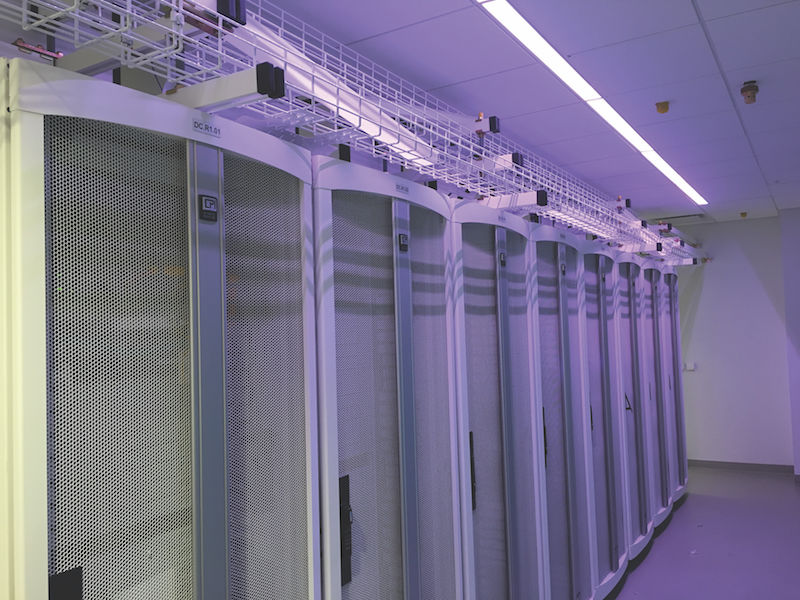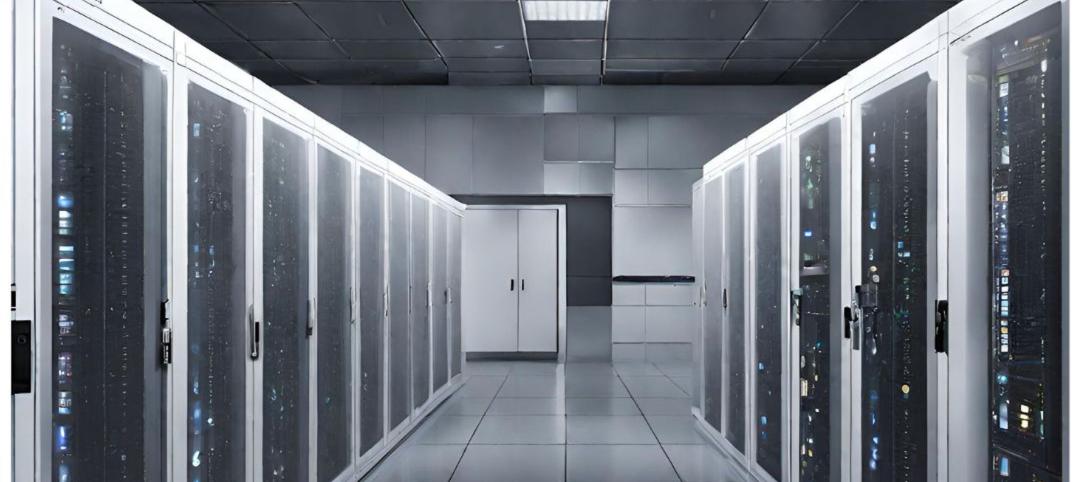As more companies move their data processing and computing to the cloud or co-location centers, some still want to maintain IT centers that are main distribution facilities (MDFs), “points of presence for their IT departments,” says Robert Sty, SmithGroup JJR’s Mission Critical Studio Leader.
Over the past two years, SmithGroup has been getting more requests from clients for micro data centers that provide that presence. One such facility is a 2,500-sf data center inside a two-story, 60,000-sf commercial office building in the Phoenix area, whose construction was completed last May.
Sty requested that the names of the client, the general contractor, and the designer of the building be withheld. But he did confess that this data center was “kind of an afterthought,” as it was being planned while the building was under construction.
The micro data center holds 32 server cabinets, supporting mechanical and electrical equipment (N+1 configuration), a shipping/receiving area, and an IT lab for build/burn-in testing for servers.
“It was like putting 10 pounds in a five-pound bag,” he says. To make this work, SmithGroup JJR raised the cabinet density to 7kW per unit. “But that created a heat load,” says Sty, which would be problematic if the cooling system went down.
The solution was to install a battery-powered flywheel backup uninterruptible power supply (UPS) onto the computer room air conditioner so the fans would keep circulating air during a power failure.
SmithGroup also deployed hot-aisle containment, a method of cooling that uses a physical barrier to guide hot exhaust airflow from server racks back to the AC return. It cools the front and back of the aisles, and mwwaintains an average room temperature of 70-75ºF.
Sty says that any client whose IT group asks for a micro data center that never goes down needs to appreciate that offices and other nonresidential spaces don’t always have the necessary infrastructure, such as a second utility feed or centralized cooling plant. Floors under data centers need to be able to handle at least 150 pounds per sf, compared to the 50-100 psf that offices are built to support. (The Phoenix office was designed to carry the heavier load.)
Data centers, regardless of size, take up more space than most clients realize. “We had to get real tight” with the mechanical and electrical equipment to keep it off of the data center floor, says Sty.
So far, the client’s feedback has been positive. Phoenix had an unusually hot summer, with outdoor temperatures rising as high as 117ºF. But the data center “has been holding the temperature to where it’s easy enough to work around,” says Sty. And the clearances proved to be satisfactory, even with larger cabinets.
Related Stories
Giants 400 | Oct 2, 2023
Top 60 Data Center Engineering Firms for 2023
Jacobs, Burns & McDonnell, WSP, EXP, and Alfa Tech head BD+C's ranking of the nation's largest data center sector engineering and engineering/architecture (EA) firms for 2023, as reported in Building Design+Construction's 2023 Giants 400 Report.
Giants 400 | Oct 2, 2023
Top 30 Data Center Architecture Firms for 2023
Corgan, HDR, Gensler, Page Southerland Page, and HED top BD+C's ranking of the nation's largest data center sector architecture and architecture/engineering (AE) firms for 2023, as reported in Building Design+Construction's 2023 Giants 400 Report.
Data Centers | Sep 21, 2023
North American data center construction rises 25% to record high in first half of 2023, driven by growth of artificial intelligence
CBRE’s latest North American Data Center Trends Report found there is 2,287.6 megawatts (MW) of data center supply currently under construction in primary markets, reaching a new all-time high with more than 70% already preleased.
Data Centers | Sep 15, 2023
Power constraints are restricting data center market growth
There is record global demand for new data centers, but availability of power is hampering market growth. That’s one of the key findings from a new CBRE report: Global Data Center Trends 2023.
Giants 400 | Aug 22, 2023
Top 115 Architecture Engineering Firms for 2023
Stantec, HDR, Page, HOK, and Arcadis North America top the rankings of the nation's largest architecture engineering (AE) firms for nonresidential building and multifamily housing work, as reported in Building Design+Construction's 2023 Giants 400 Report.
Giants 400 | Aug 22, 2023
2023 Giants 400 Report: Ranking the nation's largest architecture, engineering, and construction firms
A record 552 AEC firms submitted data for BD+C's 2023 Giants 400 Report. The final report includes 137 rankings across 25 building sectors and specialty categories.
Giants 400 | Aug 22, 2023
Top 175 Architecture Firms for 2023
Gensler, HKS, Perkins&Will, Corgan, and Perkins Eastman top the rankings of the nation's largest architecture firms for nonresidential building and multifamily housing work, as reported in Building Design+Construction's 2023 Giants 400 Report.
Market Data | Aug 1, 2023
Nonresidential construction spending increases slightly in June
National nonresidential construction spending increased 0.1% in June, according to an Associated Builders and Contractors analysis of data published today by the U.S. Census Bureau. Spending is up 18% over the past 12 months. On a seasonally adjusted annualized basis, nonresidential spending totaled $1.07 trillion in June.
Data Centers | Apr 14, 2023
JLL's data center outlook: Cloud computing, AI driving exponential growth for data center industry
According to JLL’s new Global Data Center Outlook, the mass adoption of cloud computing and artificial intelligence (AI) is driving exponential growth for the data center industry, with hyperscale and edge computing leading investor demand.
Sustainability | Apr 4, 2023
NIBS report: Decarbonizing the U.S. building sector will require massive, coordinated effort
Decarbonizing the building sector will require a massive, strategic, and coordinated effort by the public and private sectors, according to a report by the National Institute of Building Sciences (NIBS).

















